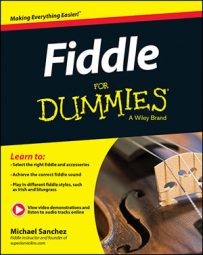You can improv with rhythms on the fiddle, which adds a lot to playing a melody line. Check out this chord progression, D-D-G-G. All the notes are from the notes of each chord.
![[Credit: Figure by Michael Sanchez]](https://www.dummies.com/wp-content/uploads/459390.image0.jpg)
Instead of filling in the rest with quarter notes, try to use eighth notes.
![[Credit: Figure by Michael Sanchez]](https://www.dummies.com/wp-content/uploads/459391.image1.jpg)
In this progression, some notes have been switched around and some half notes are plugged in to show you another variation. Remember, there has to be a total of four beats in each measure.
This fiddle progression is much closer to a “cool” melod. Sticking to a safe note for the first note of each measure is a good rule of thumb, but after that, it’s much better to have a free mind and find your way back to the safe note.
Even more important than hitting a safe note per measure is hitting the right note when the guitar player changes his chord. Say you have a D progression for a few measures. You could “wander” away from the safe note for the entire two measures and aim to hit the chord change in the next measure. That’s what’s going to make your sound musical and get the applause you want from the audience.
Make sure that, at minimum, you hit a safe note on each chord change. Try tapping your foot to know when the chord changes are happening so that you and the guitarist hit the change at exactly the same time.

